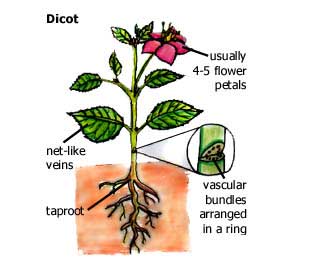Classification allows us to arrange all the different organism into neat groups in order to allow us to easily identify different species easily if they are put into groups with other organisms who share similar characteristics. Moreover, classification allows us to predict which group or taxa the organisms is roughly in based on the fact that different taxa’s share common characteristics which becomes more and more specific as we move down the taxa system. Also, classification allows us to see the evolutionary links because if organisms share similar characteristics then it can be an indication that they share a common ancestor because classification emphasizes homologous structures as traits which are common using classification may be traced back to a common ancestors. Lastly, classification allows effective communication if all scientists use the same terminology allows scientists to have a common language so that they can easily share findings.
5b) Draw a labelled diagram to show the external parts of a NAMED dicotyledonous plant. [5]
Binomial name: Catharanthus roseus
common name: Madagascar Periwinkle
5c) Explain how roots absorb water and then transport it to the xylem, noting any special adaptations that help these processes to occur. [9]
Transport of water into the roots occurs by a process called osmosis. Osmosis is the movement of water from an area of high water concentration to an area of low water concentration across a partially permeable membrane. This process is only possible because the concentration of water in the soil is greater than inside the cells. Water then crosses the epidermal cells of the root hair and travels by 2 possibly routes. The first route is called the apoplastic root. This is when water move into the root hair straight through the cell walls. It does not penetrate through the cell wall and through the plasma memebrane but instead seeps through the cell wall (analogy: like water seeping through blotting paper) and move within the extracellular spaces (spaces outside of the cell). However, the water cannot get into the endodermic because of the Casparian strip which is impermeable to water. Therefore the water has to pass through the endodermal cell (this time water goes through a plasma membrane) and then it enters the vascular tissue that is the xylem. This is an adaptive process which allows selective filtering of certain minerals in the water because the plasma membrane of the endodermal cells are permeable to certain minerals.
The second route is called the symplastic route whereby the water move into the roote hairs and they go straight through the plasma membrane and straight through the endodermal cells and into the vascular tissue as in the apoplastic route.
Specifical adaptations:
The roots have a large surface area in relation to their volume by having the branching of the roote and root hairs increase the surface area even more. Since water is absorbed into the roots by osmosis it is only possible because of the solute concentration difference inside the root being higher inside the root then in the soil. This solute concentration is created by the active transport of mineral ions into the root. Lastly, once water enters xylem it is transported UPWARDS due to the transpiration pull (analogy: tugging a rope) which is made possibly by the polar nature of water molecules which result in hydrogen bonding resulting in the cohesion between water molecules.
A diagram to show the two different routes that water can take to reach the xylem
Reference [URL]: http://www.bodine.phila.k12.pa.us/herbstritt/PlantScienceCurriculumSummary.pdf


Well done, Mot
ReplyDelete